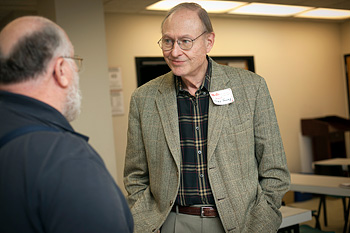
This artist's rendering shows the giant CCAT (note car in foreground), to be built at 18,400 feet above sea level on the Cerro Chajnantor mountain in Chile's Atacama desert. With an extremely wide field of view, CCAT will give astronomers a new window into the epoch of star and galaxy formation to answer some of the most fundamental questions of cosmology. It will also enable large-scale surveys of the sky and complement the nearby international Atacama Large Millimeter Array (ALMA), now nearing completion. Image courtesy of DSL and E. Donoso.
Alum helping build 'biggest, baddest thing on Earth'

Fred Young '64, M.Eng. '66, MBA '66, attends the Friends of Astronomy "Frontiers of Astronomy" symposium Nov. 9 in Cornell's Space Sciences Building. Photo: Cornell University Photography.
High on a Chilean mountaintop earlier this year Fred Young '64, M.Eng. '66, MBA '66, stood marveling at the site of the technological wonder he is helping bring into existence. The design for CCAT (Cerro Chajnantor Atacama Telescope), the world's largest submillimeter (far infrared) wavelength telescope, with its primary mirror diameter of 25 meters (82 feet), "just blows me away," says Young.
"This will be, by an order of magnitude, the most powerful telescope in the world in our wavelength. The science that is going to be done will be really spectacular. [It will be] the biggest, baddest thing on Earth in its range." (Watch a video about CCAT narrated by Young.)
At 18,400 feet, supplemental oxygen is a must for humans to work on CCAT. Young recalls his first visit to a nearby potential site for the telescope when he hadn't acclimated to the altitude and neglected to use oxygen. He called his wife on a satellite phone and started to cry while telling her how beautiful the Andes were and that he could see Argentina from the mountaintop. "I was quite silly with hypoxia [oxygen deprivation]," he says with a laugh.
Young's passion for astronomy runs deep. "Cosmology is the ultimate context for any intellectual endeavor," he explains. "It includes the story of the origins of life, of comets seeding the planet with organic molecules. How did the universe form -- that's what fascinates me."
CCAT project director Riccardo Giovanelli says Young has been instrumental in keeping the project moving forward: "His enthusiasm for CCAT and his generous support have made all the difference."
CCAT is not the first astronomy project Young has been intimately involved with. He served on the science team for the Stardust NeXt mission and was at the Jet Propulsion Laboratory (JPL) during the spacecraft's 2011 fly-by of comet Tempel 1. "It was really fascinating to get inside a mission and to see the thrill of the encounter," Young says.
He was also part of the excited crowd at JPL when the Mars Exploration Rover Opportunity landed in 2004. "The people in the room just erupted," he recalls. "It was a very emotional time."
Young retired as CEO and former owner of Young Radiator Co., an automotive component supplier. On one of his trips with astronomy Professor Emeritus Joseph Veverka, he discovered a serendipitous connection between his professional past and his astronomy interests: the Caterpillar diesel generator sets used by NASA's Deep Space Network (radio antennae for communicating with unmanned spacecraft) use radiators made by his company. "It was just a coincidence, but rather pleasing," says Young.
Retirement has enabled Young to pursue his many interests. Great ape conservation is another of his passions; his phone's ringtone is a vocalization of a bonobo (a close relative of the chimpanzee). When Young discovered that the Lab of Ornithology's Macaulay Library had numerous chimpanzee vocalizations but not a single bonobo, he was determined to provide one, and did -- though not without significant effort.
He's also a committed supporter of think tanks and activist groups of what he calls "the classical liberal (a.k.a. libertarian) persuasion." He serves as a director of the Cato Institute and of the Reason Foundation and is a member of the international Mont Pelerin Society.
Young's wife, Sandra, is a popular romance novelist, with more than 30 books published under the pen name Brittany Young. The couple have two grown children and reside in Racine, Wis.
Linda B. Glaser is a staff writer for the College of Arts and Sciences.
Links:
Bonobo vocalization in Macaulay Library
CCAT video narrated by Fred Young